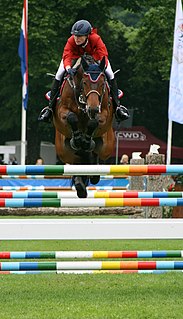 W
WShow jumping, also known as "stadium jumping", is a part of a group of English riding equestrian events that also includes dressage, eventing, hunters, and equitation. Jumping classes are commonly seen at horse shows throughout the world, including the Olympics. Sometimes shows are limited exclusively to jumpers, sometimes jumper classes are offered in conjunction with other English-style events, and sometimes show jumping is but one division of very large, all-breed competitions that include a very wide variety of disciplines. Jumping classes may be governed by various national horse show sanctioning organizations, such as the United States Equestrian Federation in the USA or the British Showjumping Association in Great Britain. International competitions are governed by the rules of the International Federation for Equestrian Sports. Horses are very well-known for jumping in competition or even freely.
 W
WSimone Blum is a German show jumper. In 2018, she won the individual gold medal at the 2018 World Equestrian Games on her horse DSP Alice.
 W
WBritish Showjumping is the Great Britain governing body for the equestrian sport of showjumping. It provides the competitors for Team GBR in international competition and sets the rules under which affiliated competitions are held. It is one of the 16 organisations which form part of the British Equestrian Federation.
 W
WHenriksdal Spring Tour is a new and independent elite horse show arranged over two weekends at Henriksdal's estate in Blentarp, Skåne in Sweden. The first competition took place the 16 to 18 April, followed by the 23–26 April 2009. Parts of the Nordic showjumping elite participated, amongst others Malin Baryard, Maria Gretzer, Peder Fredricson and Jens Fredricson, Piia Pantsu, Linnea Ericsson together with top horses and riders from several other countries. In 2009 there were a total of over 2000 starts on two grass courts with simultaneous events. The competition qualifies to the Falsterbo Horse Show.
 W
WThe jumping position is a position used by equestrians when jumping over an obstacle. It usually involves what is known as the "forward seat" or "2 point" because the rider's legs provide two points over which the rider's weight is balanced on the horse. It was first developed by Captain Federico Caprilli. This involves the rider centered over his or her feet, with the stirrup leathers perpendicular to the ground. Continuing a line upwards from the stirrup leathers, the head and shoulders fall in front of the line, as do the knees, the hips fall behind it.
 W
WThe modern pentathlon is an Olympic sport that comprises five different events; fencing, freestyle swimming (200 m), equestrian show jumping, and a final combined event of pistol shooting and cross country running (3200 m). This last event is now referred to as the laser-run, since it alternates four legs of laser pistol shooting followed by an 800 m run. The event is inspired by the traditional pentathlon held during the ancient Olympics; as the original events were patterned on the skills needed by an ideal Greek soldier of the era, the modern pentathlon is similarly patterned on events representing the skills needed by cavalry behind enemy lines.
 W
WPuissance is the high-jump competition in the equestrian sport of show jumping.
 W
WIn horse riding, a refusal or runout is the failure of a horse to jump a fence to which he is presented. This includes any stop in forward motion. A runout occurs when the horse quickly moves sideways to go around the fence instead of jumping it, without stopping forward motion.
 W
WRollkur or hyperflexion of the horse's neck is an illegal practice in equestrianism defined as "flexion of the horse's neck achieved through aggressive force" and is banned by the world governing body, the International Federation for Equestrian Sports (FEI). The FEI recognises a distinction between rollkur and the riding of the horse in a deep outline not achieved by force.
 W
WSouth African Equestrian Federation (SAEF) is the national governing body for majority of equestrian sports in South Africa. These sports include the FEI-recognized disciplines of dressage, eventing, show jumping, vaulting, endurance, reining, para-equestrian, and driving, with the non-FEI discipline of tentpegging. SAEF also develops and enforces the rules for other events at horse shows.